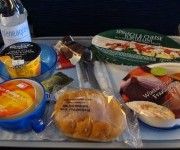A deep-frozen airline meal.
Food Studies features the voices of 11 volunteer student bloggers from a variety of different food- and agriculture-related programs at universities around the world. You can explore the full series here.
“Airline meals are just awful! Why in the world would you want to learn about that?”
This is the usual reaction I get from people when I tell them what I have been studying for the past three years. Airline meals are notorious for their poor quality and tastelessness. It’s now the norm to pack your own meal for domestic short-haul flights. Many airlines have cut back or eliminated meal service all together.
On the other hand, some airlines, especially in Asia, Europe, and the Middle East, have bumped up the quality, composition, and presentation of their meals. It may be hard to imagine, but I really enjoy eating Korean Air’s bibimbap (rice mixed with vegetables, meat, sesame oil, and koch’ujang — a hot pepper paste) on my way to and from Seoul — it is light, flavorful, and nutritious.
My interest in airline meals was first piqued when I flew Air Mauritius in May 2008. Right before dinner was served, a short video clip was screened throughout the cabin. It showed serious chefs in uniform cooking in front of dancing flames, accompanied by a voice-over describing the history and cultural context of authentic Mauritian cuisine. I ate my spicy fish and tomato curry with basmati rice with curiosity — and found it to be quite tasty.
After that, I began wondering what role food plays in airplanes and how national cuisines are represented and promoted in the air. I began collecting menus, talking with flight attendants, observing what other passengers were eating or not eating, and tasting as many different dishes I could.
After writing papers on the airplane as an actively constructed tourist site and conducting a nutritional analysis of airline meals, I was ready to gain some insight into how airline meals are prepared, transported to the aircraft, and served. I wanted to work for LSG Sky Chefs in Korea because it is known for its state-of-the-art facilities: Meals are cooked from scratch by professionally trained chefs rather than the industry norm of computerized systems that produce frozen meals.
Luckily for me, this past summer I was able to secure an internship with Chef Remo Berdux, the Executive Production Manager at LSG Sky Chefs. Chef Berdux has been in the hospitality industry for over 30 years and has worked all over the world in international hotel chains. Right from the start, Chef Berdux took care to introduce me to all the ins and outs of the airline catering industry. I spent time in production planning, the preparation room, the Halal kitchen, and the hot and cold kitchens.
During my internship, the kitchen was producing approximately 34,000 meals a day, for carriers as varied in national affiliation as Asiana, Lufthansa, Thai Airways, Etihad, Delta, China Southern, and Turkish Airlines. I saw how orders are placed and fine-tuned for production, and how raw ingredients are broken down and appropriately portioned to fit the various specifications of different meal components and menus. I also learned how meals are first cooked, than blast-chilled, before being plated up in precisely measured serving sizes. I was struck by the employees’ focus and precision despite the high speed and intensity of production.
While I had started off the internship expecting to learn the processes and business model of airline catering, what I ended up discovering was that there was an actual human being behind these meals, putting all their creativity and passion into food that is all too often ignored and dismissed. Chefs from famous restaurants in Seoul collaborated on menu development and the test kitchen regularly tried new menu items.
For example, throughout my internship, Kim In Sik, the head chef of the Halal kitchen, worked diligently to perfect his hummus recipe by testing different ratios of ingredients. He had never tried hummus before (it’s not widely available in Korea), so he first tasted all the new ingredients on their own before mixing them together. He received help from an expert and incorporated feedback from his colleagues before finalizing the recipe.
Other chefs had previous experience on Code One, the Korean Presidential airplane, or as flying chefs, making fresh sushi on demand for business and first class passengers on trans-Pacific flights. In recent years, LSG Sky Chefs Korea has responded to the increased demand and interest in Korean meals on board by developing Korean dishes such as ssam bap (lettuce wraps with meat and rice) and galbi jjim (braised beef).
All the chefs I encountered over the summer were dedicated, enthusiastic, and proud of their work. The majority of them had worked in upscale hotel restaurants before, and everyone shared stories of how former coworkers laughed at them when they decided to switch into a less glamorous sector. For them, though, airline catering was a rewarding and challenging way to provide safe, tasty, and culturally appropriate meals to a large clientele. Now, when the plastic tray is put down on my seat-back table, I see the faces behind each separate meal component.




